lab members
Click for Lab NewsClick for Lab Alumni
 Klaus Hahn, Ph.D.
Klaus Hahn, Ph.D.Thurman Distinguished Professor of Pharmacology
khahn[at]med.unc.edu
NIH Biosketch - 03-2025

Greg Alspaugh
MD/PhD Graduate Student
gregory_alspaugh[at]med.unc.edu
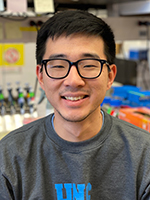
Mingyu Choi
Graduate student
mingyuc[at]live.unc.edu
My PhD project focuses on investigating how mechanosensing behaviors of podosomes regulate adhesion signaling during phagocytosis. To directly control podosome dynamics, I am developing adhesion molecule analogs that can be controlled with light. Additionally, I am developing novel biosensors for key signaling molecules involved in phagocytic signaling. Combining these tools will allow me to probe how cells convert mechanical information to cellular signaling during phagocytosis, and potentially to decipher the role of signaling oscillations in sensing and responding to the mechanical properties of the substrate.

Saygin Gulec
Graduate Student
sayging[at]live.unc.edu
I study GTPases and how the feedback loops they participate in result in spatiotemporal patterns that lead to the emergence of complex cellular behaviors. One of these behaviors is the formation of podosomes during phagocytosis. I use novel biosensors developed in our lab to track the activity of individual GTPase molecules and use this data to build mathematical models that helps us analyze and understand the regulatory reaction network that gives rise to such behaviors.
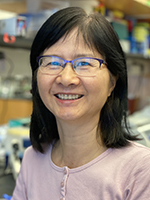
Lihua He, Ph.D.
Research Assistant Professor
lhe[at]email.unc.edu
The “binder/tag” approach, which utilizes the interaction of a 7 amino acid peptide SsrA (tag) and a small protein SspB (binder) to reveal protein conformation, has been employed to probe the conformational changes of individual Src family proteins in living cells. My research extends this approach to identify orthogonal binder/tag pairs for multiplexed biosensor imaging, and applies the binder/tag approach to report the activities of Rho family GTPase guanine exchange factors (GEFs).
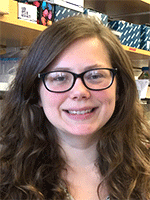
Megan Kern
Graduate Student
megkern[at]live.unc.edu
My project, working between the Hahn and Superfine labs, uses combined Atomic Force Microscopy (AFM) and line-Bessel light sheet imaging to study engulfment forces during phagocytosis. This system allows for fast, high resolution imaging in the plane of force as well as volumetric imaging synchronous with sensitive AFM force measurements. With this system we have correlated the accumulation of actin around antibody-coated phagocytic targets to downward, cell-driven engulfment forces. In 3D, we have also observed podosomes in the early stages of phagocytic cup formation. Currently, we are working on a model based on parametrized geometrical quantities of the target contact area to fit the observed engulfment forces during phagocytosis. Furthermore, we have attached deformable and fluorescently labeled polyacrylamide beads to the AFM cantilever, now allowing us to investigate the local, podosome-driven deformations on the target as well as the overall downward engulfment forces.
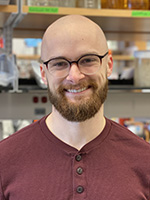 Gabe Kreider-Letterman, Ph.D.
Gabe Kreider-Letterman, Ph.D.
Postdoctoral Fellow
Gabriel_Kreider-Letterman[at]med.unc.edu
Key to cancer cell metastasis is the ability of cancer cells to invade through their extracellular environments. The changes that occur during this process involve coordination between multiple signaling pathways that are linked to cell adhesion and matrix remodeling. The relationship between the intracellular signaling and the extracellular environment is bidirectional - intracellular signals influence how cells respond to their environment, and differences in the extracellular environment modulate intracellular signaling that determines cell behavior. My research focuses on understanding how cancer cells sense their extracellular environment through mechanosensitive proteins, and how mechanical forces are translated into intracellular signals. To achieve this, I am pursuing the following directions:
1. I am using the recently developed Binder/Tag approach to generate biosensors for the key mechanosensitive protein Talin, which integrates force sensing with many signaling pathways. This tool allows for precise visualization of Talin conformational changes, induced by acto-myosin forces, and the resulting changes in Talin scaffolding function. Understanding when and where tension induces scaffolding changes in Talin will reveal how Talin coordinates responses to heterogeneous forces and ECM interactions.
2. Using our new capacity for biosensor multiplexing, I am exploring how cellular signals from the Rho family of GTPases are regulated within and around cellular adhesions. I am particularly focusing on invadopodia, degradative adhesion structures that facilitate cancer cell invasion by remodeling the ECM. Although it is known that Rho GTPase activity is regulated by invadopodia, the mechanism and role of GTPase coordination at these structures is not yet well understood. Gaining insights into Rho GTPase signaling at invadopodia will not only deepen our understanding of invadopodia-based invasion, but also have broader implications for the localized regulation of Rho GTPases by specific structures.
 Liz McInnis
Liz McInnisGraduate Student
ealderma[at]email.unc.edu
I am a graduate student working with Klaus Hahn and Ron Falk to investigate the dynamic pathways involved in patients with Minimal Change Disease (MCD). MCD is a rare inflammatory disease that causes kidney damage primarily in young children, due to the loss of podocyte foot processes. Podocyte foot processes form a junction called the slit diaphragm, which acts as a filter keeping large proteins from leaking into the urine. A central question in the field is what drives the morphological changes of podocytes in patients with MCD. I am exploring this with traditional approaches and by developing a biosensor to study how the protein nephrin interacts with neighboring cells to form the slit diaphragms.
 Vairaprakash Pothiappan, Ph.D.
Vairaprakash Pothiappan, Ph.D.Postdoctoral Fellow
pothi[at]email.unc.edu
Trained in Synthetic Organic Chemistry, and development of various photo-functional molecules, my current interest in Hahn lab is in developing biosensors. I am focused on tailoring funcional fluorophores for single-molecule tracking of conformational changes in live cells, and techniques to report conformation in super resolution microscopy.
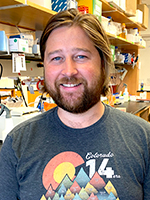
Joseph Szulczewski, Ph.D.
Postdoctoral Fellow
jszulczewski[at]unc.edu
Migrating cells respond to increasing stiffness gradients, an important factor in fibrosis and cancer metastasis. The major mechanisms underlying how stiff environments can be translated into migration signals is not well understood. Focal adhesions are complex, dynamic organelles that enable cells to sense the stiffness of their local environment by linking the actin cytoskeleton to the extracellular substrate. This link at focal adhesions controls a number of signalling pathways, including activation of RhoGTPases. The major underlying mediators that translate high mechanical tension to RhoGTPase activity have yet to be identified. We aim to discover novel tension-sensitive signaling pathways, and understand the mechanisms of respone to tension by developing analogs of the following molecules:
1. Vinculin, known as the cell’s molecular clutch, is a prominent linker of focal adhesions to the actin cytoskeleton. Using optogenetic regulation of engineered domains allosterically coupled to vinculing binding sites, I am controlling vinculin-actin interactions. I will control focal adhesion tension and study how this locally controls cell protrusion pathways.
2. Vinculin and p130cas undergo dramatic conformational changes due to fluctuations of mechanical strain felt at focal adhesions. Using our novel binder/tag technology, I aim to create a biosensor that will quantify stretch-induced conformational changes and binding interactions of p130cas and vinculin at focal adhesions. I will correlate focal adhesion tension with localized RhoGTPase activity, and use these analogs to create a high throughput assay to identify novel tension-sensitive proteins.
3. Durotaxis assays traditionally utilize a stiffness gradient that spans an entire coverslip, but fails to capture the local cell-scale anisotropic stiffness gradients that migrating and metastasizing cancer cells experience in vivo. In order to address this, I have developed a novel topology independent micropillar assay (TIM) that will allow us to investigate the role that local anisotropic traction stresses have on protrusion activity/ cell polarity and local RhoGTPase activity.
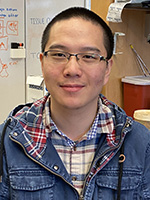
Pengning Xu, Ph.D.
Postdoctoral Fellow
pengning[at]unc.edu
I am interested in developing novel biosensors as well as improving optical instrumentation and quantitative analysis for single particle tracking (SPT), which reveals activity and diffusivity of individual biomolecules. Currently, I focus on using SPT to reveal the mechanism of the Cdc42 GTPase signaling in cell migration organelles such as podosomes, invadopodia, and focal adhesions.
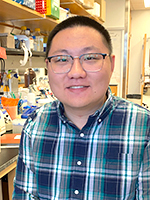 Yu Yan, Ph.D.
Yu Yan, Ph.D.Postdoctoral Fellow
yu_yan[at]med.unc.edu
I am interested in designing and synthesizing environment-sensing fluorescent dyes that report changes in their surrounding micro-environment, including protein conformational changes. Currently, my project is focused on merocyanine derivatives conjugated with affinity groups for biosensors used in single particle tracking (SPT).

Future Postdoctoral Fellow, Graduate Student or Tech
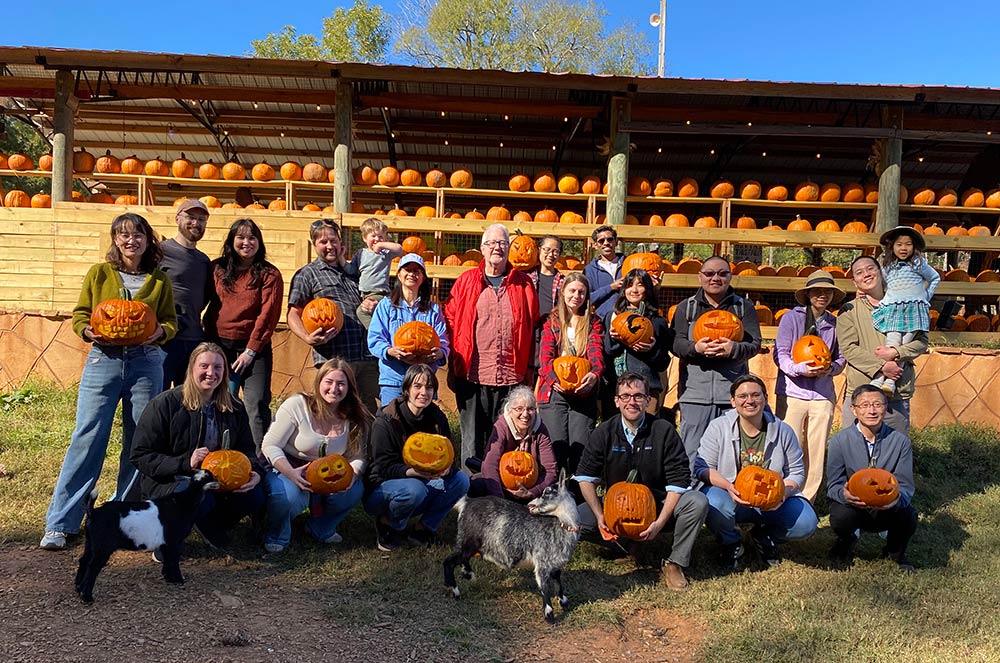 Hahn lab at Spring Haven Goat Farm 2024
Hahn lab at Spring Haven Goat Farm 2024


